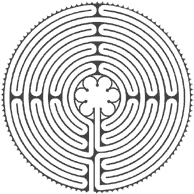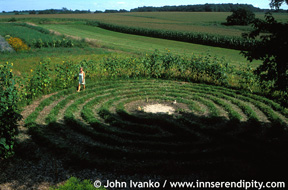

 Unlike a maze, a complex puzzle with branch points and dead ends, the magical labyrinth is a one-directional pathway which typically reflects a balanced symmetry and pattern which is not meant to confuse or trick the walker. There are two popular labyrinth designs: the ancient Cretan labyrinth and the circuit labyrinth which is based on the number of times the path loops around the center. Entry to our 7-circuit Inn Serendipity Labyrinth is made from the side, taking us to the center without any choices to be made; once there, we retrace our steps to exit the labyrinth.
Unlike a maze, a complex puzzle with branch points and dead ends, the magical labyrinth is a one-directional pathway which typically reflects a balanced symmetry and pattern which is not meant to confuse or trick the walker. There are two popular labyrinth designs: the ancient Cretan labyrinth and the circuit labyrinth which is based on the number of times the path loops around the center. Entry to our 7-circuit Inn Serendipity Labyrinth is made from the side, taking us to the center without any choices to be made; once there, we retrace our steps to exit the labyrinth.Labyrinths have been used in many of the Gothic cathedrals of Europe, for fertility rituals by pre-Christian agrarian societies and as magical talismans by Swedish fishing communities. The ancient Cretan design was based on clay tablets found in Pylos, Greece. The Native American Hopi nation consider their 4-circuit labyrinth design a symbol for Mother Earth. The Celts used labyrinths in their art. Among the best known and most visited labyrinths are found at the Chartres Cathedral in Paris and Grace Cathedral, atop Knob Hill in San Francisco. While the labyrinth is a Western concept, it resembles the mandalas of Buddhism and the practice of walking in Zen meditation, both of which calm and proffer opportunity for awareness. Adjacent sketch is of the eleven circuit floor pattern of the labyrinth at the Chartres Cathedral.
Drawn into the ancient world of labyrinths, we were awestruck by both the beauty of the labyrinth and its message: know thyself.  Perhaps the most widespread interest and use of the labyrinth today is its power to help us slow down, look within and seek balance in our life. The purpose of walking the labyrinth is not to quickly get to the center, since we'll get there soon enough. Time is not of the essence. Rather, the goal is to center ourselves and consciously dwell in the present. By walking the pathways, the magical properties of the labyrinth quiets the mind and soul, easing away the hustle and bustle of day-to-day living. According to the non-profit organization, Veriditas, the world-wide labyrinth project, there are three stages of the labyrinth walk: (1) Purgation, a releasing, a letting go of the details in our life, quieting and emptying the mind; (2) illumination, the arrival to the center and an unlimited time for meditation, prayer, and thought; and (3) union, the process by which we join the healing forces at work in the world, connect with nature, God, the higher power. By so connecting, we feel more empowered to continue along our journey of right livelihood and sustainable living.
Perhaps the most widespread interest and use of the labyrinth today is its power to help us slow down, look within and seek balance in our life. The purpose of walking the labyrinth is not to quickly get to the center, since we'll get there soon enough. Time is not of the essence. Rather, the goal is to center ourselves and consciously dwell in the present. By walking the pathways, the magical properties of the labyrinth quiets the mind and soul, easing away the hustle and bustle of day-to-day living. According to the non-profit organization, Veriditas, the world-wide labyrinth project, there are three stages of the labyrinth walk: (1) Purgation, a releasing, a letting go of the details in our life, quieting and emptying the mind; (2) illumination, the arrival to the center and an unlimited time for meditation, prayer, and thought; and (3) union, the process by which we join the healing forces at work in the world, connect with nature, God, the higher power. By so connecting, we feel more empowered to continue along our journey of right livelihood and sustainable living.
The labyrinth found at Inn Serendipity was designed to flow from its incorporation into a transitional organic farm and gardens. Circular in design, the Inn Serendipity Labyrinth has a diameter of about 50 feet. A wall of radiant sunflowers, their flower heads following the arc of the sun during the day, encircles three-quarters of the labyrinth. Oriented like a compass, with the entry point on the west side, each loop radiates inward--north, east, south and west--until the walker reaches the center. The two-foot wide woodchip pathways are marked by clover with fragrant perennial creeping thyme groundcover slowly being established along with perennial flowers.
Walks are welcomed, but advance notice is requested.